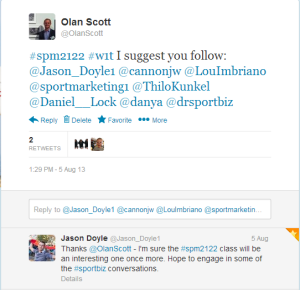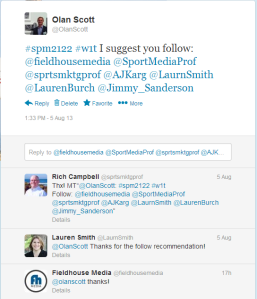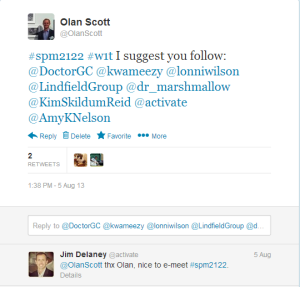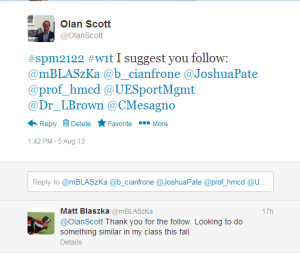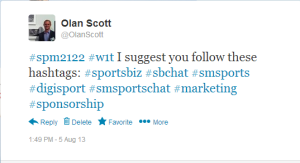As many of my readers know, I actively use twitter in my university classroom teaching. In particular, I use it most in my Sport Marketing unit (tagged #spm2122). Twice during the semester, a lecture is replaced by an online discussion on Twitter. The focus of the online lecture is the content from the four weeks prior. Here are the four topics that will be discussed in a QandA fashion on the 27th of August 2013 that starts at 12:30PM Perth time.
Live Tweet topics for 27 August 2013 that starts at 1230 (12:30 PM) Perth time.
The topics will all be listed below with relevant links, but the questions will remain secret until the live chat.
The rationale for this classroom assessment item is:
-To uncover whether the use of social media can be used to foster student engagement in university classroom settings
-To analyse whether a micro-blogging service could enhance:
-the co-creation of unit content,
-enable real-world examples to be brought into the classroom, and
-foster engagement with unit materials
SPM2122 has two textbooks that are used. They are:
Shilbury, D., Quick, S., & Westerbeek, H. (2009) Strategic sport marketing (3rd ed.). Sydney: Allen &
Unwin. See: http://www.allenandunwin.com/default.aspx?page=94&book=9781741756265
Smith, A. C. T. (2008). Introduction to Sport Marketing. Sydney: Elsevier. See:
http://www.elsevier.com/books/introduction-to-sport-marketing/smith/978-0-7506-8685-3
All questions will come from unit (course) materials that were discussed in seminars from week 1 to week 4. Please review the relevant chapters from our reading list, which was:
Week 1 please read Chapters 1 and 2 from the Shilbury et al text
Week 2 please read Chapters 1 & 2 from the Smith text
Week 3 please read Chapter 3 from the Shilbury et al text
Week 4 please read Chapter 4 from the Shilbury et al text
Topic 1:
The Smith textbook outlines two streams of sport marking, which is unique to the sports industry. “Sport marketing is the application of marketing concepts to sport products and services, and the marketing of non-sport products through an association to sport. Sport marketing therefore has two key features. First, it is the application of general marketing practices to sport-related products and services. Second, it is the marketing of other consumer and industrial products or services through sport. Like any form of marketing, sport marketing seeks to fulfil the needs and wants of consumers. It achieves this by providing sport services and sport-related products to consumers. However, sport marketing is unlike conventional marketing in that it also has the ability to encourage the consumption of non-sport products and services by association” (Smith, 2008, p. 3). In our online discussion, we will discuss both of these concepts and apply them to sport marketing using social media.
You may be asked to give examples about:
-Marketing of sport on social media
-Marketing through sport on social media using a sport team’s account
Topic 2:
Smith (2008) suggests that “the idea of branding is closely linked with positioning. A brand is like an identifying badge, often reinforced by a name or a logo that helps consumers recognise a product or an organisation. A brand becomes linked with consumers’ opinions and perceptions of a sport product and organisation” (p. 115). In week 2, we discussed positioning strategies of various brands.
In the discussion of this topic, you will be asked to give examples of brand attributes “(aspects of the brand that are defining, unique and special to each organisation)” (Smith, p. 118) of several sporting teams. On page 118 of the Smith text, there is an interactive case that might help you in preparing for this topic.
You may be asked to give examples of:
-Unique elements of your favourite sports team
-Distinctive partnerships between a company and an athlete
-Unique elements of a sport company (shoes, bats, media, etc.)
Topic 3:
In week four, we discussed three ways in which sport organisations can collect data. These were: General market data, individual consumer’s data, and competitors and/or participants’ data.
General market data include all the information which relates to the broad environment in which the sport operates. Individual consumer’s data concerns their attitudes and behaviours related to a specific sport product or service. A third source of information for sporting organisations relates to competitors and their participants. It is critical that sporting organisations not only be aware of who their competitors are but also know the consumers of a rival’s products or services (adapted from Shilbury et al., 2009, p. 65).
In our discussion on this topic, we will tweet about the different methods that contemporary sport organisations use to collect data and use new media examples
You may be asked to give examples about:
-How sport teams can incentivise consumers to fill in all items in a form
-The tactics sports organisations use to accurately data mine
Topic 4:
The Big 5 Sport Motives represent a comprehensive view of major psychological inputs that represent core benefits consumer receive from engaging in sport consumption (adapted from Shilbury et al., 2009, p. 49). Various research (Beaton et al., 2007; James et al., 2006) has found that there are “five main psychological benefits that sport consumers desire from a sport experience” (Shilbury et al, 2009, p. 48). These are: Social interaction, performance, excitement, esteem, and diversion.
In our discussion of this topic, we will discuss how sport marketers use the Big 5 sport motives in an attempt to persuade individuals to consume a sporting experience.
You may be asked to give examples about:
-Ads that feature one or more of the Big 5 sport motives to entice consumers to attend a sporting match
-Ads that use the Big 5 sport motives to entice viewership of an event
-Ads using the Big 5 sport motives in an attempt to get people to participate in sport

